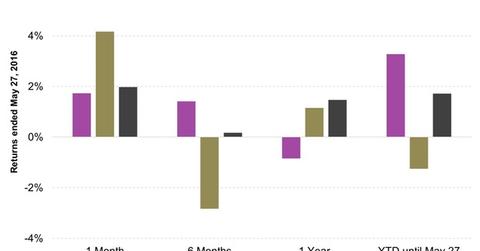How Market Conditions Have Suited FSAEX Year-to-Date in 2016
As of May 27, 2016, FSAEX had risen by 3.3% YTD (year-to-date) in 2016, making it the second-best performer among the ten funds in this review.
May 31 2016, Published 3:35 p.m. ET

Performance evaluation of FSAEX
As of May 27, 2016, the Fidelity Series All-Sector Equity Fund (FSAEX) had risen by 3.3% YTD (year-to-date) in 2016, making it the second-best performer among the ten funds in this review. We’ve graphed its performance against the PowerShares QQQ Trust, Series 1 ETF (QQQ) and the iShares Russell 1000 Growth ETF (IWF).
Let’s take a look at what has contributed to the fund’s superior performance so far in the year.
Portfolio composition and contribution to returns
Energy stocks have generally performed well since February 11, 2016. This has been reflected in the performance of FSAEX. Though stocks from the energy sector form just 6% of FSAEX’s portfolio, they’ve emerged as its biggest positive contributor YTD in 2016.
Cimarex Energy (XEC), Apache (APA), and Schlumberger (SLB) are among the stocks that have contributed positively to FSAEX, albeit in small measure. The absence of any major negative contributors has ensured that the small positive contributions from various stocks add up.
The industrials and consumer staples sectors are quite close to each other in terms of their positive contributions in 2016 so far. While industrials stocks have been led by JB Hunt Transport Services (JBHT) and HD Supply Holdings (HDS), consumer staples stocks have been led by Philip Morris International (PM).
Altria Group (MO) has also contributed positively to consumer staples’ returns, but its contribution has been quite small compared to PM.
Healthcare stocks have remained a painful point for FSAEX, though the fund hasn’t been as badly affected as some of its peers. Allergan (AGN) has been one of the sector’s worst performers, while Boston Scientific (BSX) has been among its best performers, helping to reduce the drag on FSAEX.
Comparison with QQQ
The passively managed QQQ has been unable to provide any contest to the actively managed FSAEX in 2016 so far. Except for the consumer discretionary sector, all other sectors making up FSAEX have outperformed their counterparts in QQQ.
Investor takeaway
We’ve outlined the sectors that have helped and hurt FSAEX in 2016 so far. However, it would be unfair not to mention the contributions made by the financials and utilities sectors, which have played pivotal roles in helping the fund to rise.
Note that there are restrictions in purchasing FSAEX, which we outlined in the previous article. Also, FSAEX’s role is different from the roles of other funds in this review. As its name suggests, the fund will remain invested across all sectors. This may help or hurt it depending on market conditions. At present, diversification has helped the fund. Its role is to provide access to all sectors rather than to focus on a particular set.
Let’s move to the next fund under review, the Janus Fund Class A (JDGAX).
